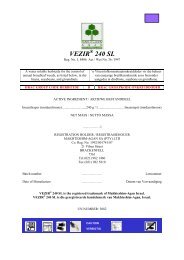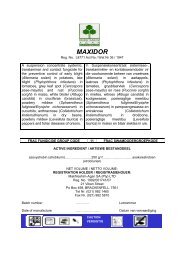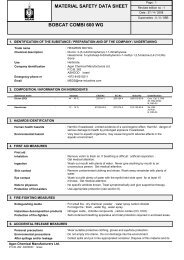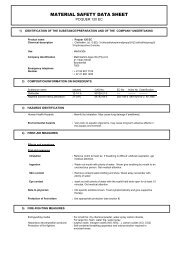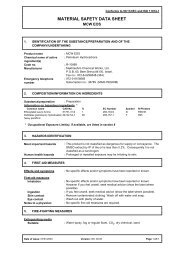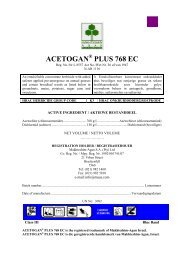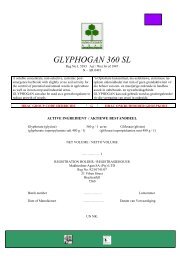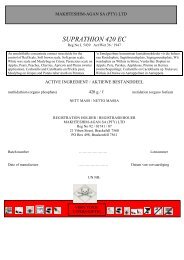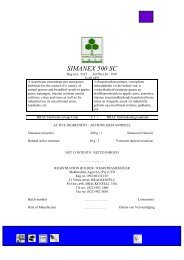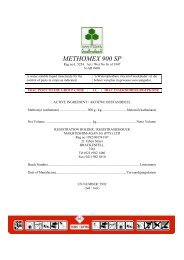CLODINAGAN 240 EC - Makhteshim-Agan
CLODINAGAN 240 EC - Makhteshim-Agan
CLODINAGAN 240 EC - Makhteshim-Agan
Create successful ePaper yourself
Turn your PDF publications into a flip-book with our unique Google optimized e-Paper software.
An emulsifiable concentrate selective postemergence<br />
herbicide for the control of annual<br />
grasses in wheat in the Western- and Eastern<br />
Cape as well as dry land and irrigated wheat in<br />
the Summer Rainfall Region<br />
<strong>CLODINAGAN</strong> <strong>240</strong> <strong>EC</strong><br />
Reg. No. L 8383 Act / Wet 36 / 1947<br />
N-AR 1053<br />
‘n Emulsifiseerbare konsentraat selektiewe naopkom<br />
onkruiddoder vir die beheer van eenjarige<br />
grasse in koring in die Wes- en Oos Kaap asook<br />
droëland en besproeide koring in die Somerreënval<br />
gebied.<br />
HRAC GROUP CODE A HRAC ONKRUIDDODERGROEPKODE<br />
ACTIVE INGREDIENT / AKTIEWE BESTANDDEEL<br />
Clodinafop-propargyl <strong>240</strong> g / ℓ Clodinafop propargiel<br />
(Aryloxyphenoxy propionate) (Arieloksiefenoksie propionaat)<br />
NET VOLUME / NETTO VOLUME<br />
……………….<br />
REGISTRATION HOLDER / REGISTRASIEHOUER<br />
<strong>Makhteshim</strong>-<strong>Agan</strong> SA (Pty) Ltd<br />
Co. Reg No. 92/01741/07<br />
21 Viben Street<br />
PO Box 498, Brackenfell, 7561<br />
Tel no. (021) 982 1460 / Fax no. (021) 982 5810<br />
Batch number ………………… Lotnommer<br />
Date of manufacture ………………… Datum van vervaardiging<br />
CAUTION<br />
VERSIGTIG<br />
Class III Blue colour band
WARNINGS:<br />
• Poisonous when swallowed<br />
• Avoid skin and eye contact<br />
• Toxic to fish<br />
• Store in a cool dry place away from food and feed<br />
• Keep under lock and key out of reach of children, uninformed persons and animals<br />
• Re-entry period: Do not enter the treated area before the spray deposit has dried out on<br />
the foliage unless protective clothing is worn<br />
• Aerial application: Notify all the inhabitants in the immediate vicinity of the area to be<br />
sprayed and issue the necessary warnings. Do not spray over or allow drift to contaminate<br />
adjacent areas, water or any other area that is not under treatment.<br />
Although this remedy has been extensively tested under a variety of conditions the registration<br />
holder does not warrant that it will be effective under all conditions. The activity and efficacy of<br />
the product may be affected by factors such as abnormal climatic and storage conditions, quality<br />
of dilution water, compatibility with other substances not indicated on the label and the<br />
occurrence of resistance of the weed against the remedy, as well as by the method, time and<br />
accuracy of application. The registration holder furthermore does not accept responsibility for<br />
damage to crops, vegetation, the environment or harm to man or animal, or for lack of<br />
performance of the remedy concerned due to the failure of the user to follow the label<br />
instructions, or to the occurrence of conditions which could not have been foreseen in terms of<br />
the registration. Consult the supplier in the event of any uncertainty.<br />
PR<strong>EC</strong>AUTIONS:<br />
• Do not inhale the spray mist<br />
• Avoid skin and eye contact. If skin is accidentally contacted wash with soap and cold water.<br />
If eyes are contacted flush eyes with clean running water for at least 15 minutes.<br />
• Wash contaminated clothing after use<br />
• Do not eat, drink or smoke while mixing and applying before washing hands and face<br />
• Avoid drift of spray to other crops, grazing, rivers, dams or any other area that is not under<br />
treatment<br />
• Prevent contamination of feed, feed, drinking water and eating utensils<br />
• Rinse the empty container three times with a volume of water of at least 10 % of that of the<br />
container. Add the rinsate to the mixing or spraying tank. Destroy the empty container by<br />
perforating and flattening it.<br />
• Do not use the empty container for any other purpose<br />
• Clean the applicator thoroughly after use. Throw the wash water where it will not<br />
contaminate crops, grazing, rivers, dams or boreholes.<br />
Resistance warning:<br />
<strong>CLODINAGAN</strong> <strong>240</strong> <strong>EC</strong> is classified as a Group Code A Herbicide. Any weed population may contain<br />
individuals which are naturally resistant to <strong>CLODINAGAN</strong> <strong>240</strong> <strong>EC</strong> and other Group Code A herbicides.<br />
The resistant individuals can eventually dominate the weed population if these herbicides are used<br />
continuously and exclusively. These resistant weeds may not be controlled by <strong>CLODINAGAN</strong> <strong>240</strong> <strong>EC</strong><br />
or any Group Code A herbicide.<br />
To delay resistance the following can be done:
• Avoid exclusive repeated use of herbicides from the same herbicide group code. Alternate<br />
or tank mix with registered products from different herbicide group codes.<br />
• Integrate other control methods (chemical, cultural, biological) into weed control<br />
programmes<br />
• Keep records for every field sprayed. Inspect each field annually for the occurrence of<br />
resistant weeds. Prevent movement of weed seed or plant material between fields and use<br />
only weed free plant material.<br />
• As it is impossible to detect resistance weeds prior to the use of <strong>CLODINAGAN</strong> <strong>240</strong> <strong>EC</strong>,<br />
<strong>Makhteshim</strong>-<strong>Agan</strong> cannot accept responsibility for any losses that result because of failure<br />
to control resistant weeds if the above mentioned measures are not adhered to:<br />
For specific information on resistance management contact the registration holder of this<br />
product.<br />
USE RESTRICTIONS AND IMPORTANT INFORMATION:<br />
• <strong>CLODINAGAN</strong> <strong>240</strong> <strong>EC</strong> should be applied to actively growing grass weeds to any wheat<br />
cultivar, provided the wheat has reached the 3-leaf stage<br />
• Do not apply <strong>CLODINAGAN</strong> <strong>240</strong> <strong>EC</strong> in wheat fields where confirmed or suspected resistance<br />
of any weed exists, where weeds are under any kind of stress like drought, very high or very<br />
low temperatures, waterlogging or where nutrient deficiencies exists.<br />
• Do not apply <strong>CLODINAGAN</strong> <strong>240</strong> <strong>EC</strong> to barley or oats or allow spray to drift over these crops<br />
• Only weeds that have germinated at time of application will be controlled<br />
• Ensure thorough coverage of the weeds. Weeds that are overshaded by other weeds or by<br />
the crop may not be controlled sufficiently.<br />
• <strong>CLODINAGAN</strong> <strong>240</strong> <strong>EC</strong> undergoes rapid degradation in the soil.<br />
DIR<strong>EC</strong>TIONS FOR USE:<br />
Use only as directed<br />
Compatibility:<br />
The compatibility of <strong>CLODINAGAN</strong> <strong>240</strong> <strong>EC</strong> with other products may be influenced by the formulation<br />
of the product (s) it is mixed with as well as the quality of the dilution water. Since the formulation<br />
of other products may change without the knowledge of MAKHTESHIM-AGAN and the quality of the<br />
water may differ from farm to farm, a physical compatibility test should always be carried out prior<br />
to application. <strong>CLODINAGAN</strong> <strong>240</strong> <strong>EC</strong> applied at 150 ml / ha in a tank mixture with MCPA may, under<br />
certain circumstances, lead to antagonism between the products.<br />
Mixing:<br />
Half fill the spray tank with water. Add the required volume of <strong>CLODINAGAN</strong> <strong>240</strong> <strong>EC</strong> to the water<br />
while agitating. Fill the tank with water while agitating until nearly full. Add the required amount of<br />
a suitable adjuvant like MCW EOS at the recommended rate.<br />
If <strong>CLODINAGAN</strong> <strong>240</strong> <strong>EC</strong> is tank mixed with other products it should be added last just before the<br />
MCW EOS is added. It is important to note that agitation should be kept up during mixing and<br />
application. Mix only sufficient mixture which can be sprayed out the same day. Do not allow the<br />
spray mixture to stand overnight.
APPLICATION:<br />
<strong>CLODINAGAN</strong> <strong>240</strong> <strong>EC</strong> should be applied to young actively growing weeds. Weeds should be wetted<br />
thoroughly, therefore the crop should not have reached a density where weeds are shadowed off at<br />
application.<br />
Ground application:<br />
<strong>CLODINAGAN</strong> <strong>240</strong> <strong>EC</strong> can be applied by any suitable medium- to high volume sprayer provided it is<br />
able to distribute the spray mixture evenly over the target area, it is fitted with an effective agitation<br />
mechanism and that it is correctly calibrated. It is recommended that flat fan nozzles are used and<br />
that a water volume of 200 lt per ha is used to get an even cover of the spray mixture on the weeds.<br />
Aerial application:<br />
Aerial application of <strong>CLODINAGAN</strong> <strong>240</strong> <strong>EC</strong> may only be done by a registered Aerial Application<br />
Operator using a correctly calibrated registered aircraft according to the instructions of SANS Code<br />
10118 (Aerial Application of Agricultural Pesticides). Ensure that the spray mixture is distributed<br />
evenly over the target area and that the loss of spray material during application is restricted to a<br />
minimum. It is therefore essential that the following criteria be met:<br />
• Volume: A minimum spray volume of 30 ℓ per ha is recommended. As the product has not<br />
been evaluated at a reduced volume rate the registration holder can not guarantee efficacy,<br />
or be held responsible for any adverse effects if this product is applied aerially at a lower<br />
volume rate than recommended<br />
• Droplet coverage: 30 – 40 droplets per cm 2 must be recovered at the target area<br />
• Droplet size: A droplet with a VMD of 350 – 450 micron is recommended. Limit the<br />
production of fine droplets less than 150 microns (high drift and evaporation potential) to a<br />
minimum.<br />
• Flying height: Maintain the height of the spray boom 3 – 4 metres above the target. Do not<br />
spray when the aircraft dives, banks or is in a climb.<br />
• Use suitable atomising equipment that will produce the desired droplet size and coverage,<br />
but which will ensure the minimum loss of product. The spraying system must produce a<br />
droplet spectrum with the lowest Relative Span.<br />
• Position all atomisers within the inner 60 – 75 % of the wing span to prevent droplets from<br />
entering the wingtip vortices<br />
• The differences in temperature between the wet and dry bulb thermometers of a whirling<br />
hygrometer should not exceed 8°C<br />
• Stop spraying if the wind speed exceeds 15 km / h<br />
• Stop spraying under turbulent unstable and dry conditions during the heat of the day<br />
• Spraying under temperature inversion conditions (spraying in or above the inversion layer)<br />
and / or high humidity conditions (relative humidity 80 % and above) may lead to the<br />
following:<br />
a) Reduced efficacy due to suspension and evaporation of small droplets in the air<br />
(inadequate coverage)<br />
b) Damage to other sensitive crops and / or non-target areas through drifting of the<br />
suspended spray cloud away from the target field<br />
c) Ensure that the Aerial Spray Operator knows exactly which fields to spray<br />
• Obtain an assurance from the Aerial Spray Operator that the above requirements will be<br />
met and that relevant data will be compiled in a logbook and kept for future reference.
Wild Oats<br />
Avena fatua<br />
APPLICATION RATES:<br />
1. Application rates for <strong>CLODINAGAN</strong> <strong>240</strong> <strong>EC</strong> in the Western and Eastern Cape in Wheat<br />
WEED DEVELOPMENT<br />
STAGE<br />
Wild Oats<br />
Avena fatua<br />
Little seeded canary grass<br />
Phalaris minor<br />
Wild Oats<br />
Avena fatua<br />
Little seeded canary grass<br />
Phalaris minor<br />
Italian ryegrass<br />
Lolium spp<br />
DOSAGE RATE<br />
PER HA<br />
3 – 4 leaf Ground application:<br />
150 ml<br />
Aerial application:<br />
165 ml<br />
3 – 4 leaf Ground application:<br />
200 ml<br />
Aerial application:<br />
220 ml<br />
3 – 4 leaf<br />
2 – 3 leaf<br />
Ground application:<br />
250 ml<br />
Aerial application:<br />
275 ml<br />
REMARKS<br />
Application prior to the 3 – 4 leaf stage of wild<br />
oats and little seeded canary grass may lead to<br />
re-germination. The hairy leaved wild oats<br />
biotypes occurring mainly in the Eendekuil and<br />
Wellington areas will not be controlled by this<br />
low rate. Antagonism may be experienced<br />
under certain conditions if <strong>CLODINAGAN</strong> <strong>240</strong> <strong>EC</strong><br />
is tank mixed with MCPA at these rates. The<br />
addition of a suitable adjuvant like MCW EOS at<br />
the recommended rate is essential.<br />
If <strong>CLODINAGAN</strong> <strong>240</strong> <strong>EC</strong> is applied prior to the 3<br />
– 4 leaf stage of Wild oats and Little seeded<br />
canary grass, re-germination might occur. Wild<br />
oats will be controlled up to the flag-leaf stage,<br />
but severe competition which will result in yield<br />
loss can be experienced if applied after the 3 – 4<br />
leaf stage. A suitable adjuvant like MCW EOS at<br />
the recommended rate is essential.<br />
Please see the remarks above<br />
Italian ryegrass sprayed after the 2 – 3 leaf<br />
stage might not be controlled effectively.<br />
NOTE: DO NOT APPLY <strong>CLODINAGAN</strong> <strong>240</strong> <strong>EC</strong> where resistance of the above grass species against the ACCase inhibitors<br />
has being proven.
Wild Oats<br />
Avena fatua<br />
Volunteer maize<br />
Zea mays<br />
Wild oats<br />
Avena fatua<br />
Sweet buffalo grass<br />
Panicum schinzii<br />
2. Application rate for <strong>CLODINAGAN</strong> <strong>240</strong> <strong>EC</strong> for the Summer Rainfall Region in irrigated wheat<br />
WEED DEVELOPMENT<br />
STAGE<br />
DOSAGE RATE<br />
PER HA<br />
3 – 4 leaf Ground application:<br />
250 ml<br />
Aerial application:<br />
275 ml<br />
REMARKS<br />
Apply 2 days after irrigation. Yield losses can<br />
occur if weeds are treated after the 4 leaf stage.<br />
A suitable adjuvant like MCW EOS should be<br />
used at the recommended rate.<br />
3. Application rates for <strong>CLODINAGAN</strong> <strong>240</strong> <strong>EC</strong> for the Summer Rainfall Region in dry land wheat<br />
WEED DEVELOPMENT<br />
STAGE<br />
DOSAGE RATE<br />
PER HA<br />
3 – 4 leaf Ground<br />
application:<br />
335 ml<br />
Aerial application:<br />
380 ml<br />
3 – 4 leaf<br />
WEED SP<strong>EC</strong>TRUM / ONKRUIDSPEKTRUM<br />
Ground<br />
application:<br />
200 ml<br />
Aerial application:<br />
220 ml<br />
REMARKS<br />
Apply after the first rains in spring if the mean<br />
temperature exceeds 10 °C over a 24 hour<br />
period for three consecutive days. If wild oats<br />
is exceeding the 4 leaf development stage<br />
during this period <strong>CLODINAGAN</strong> <strong>240</strong> <strong>EC</strong><br />
should be applied to minimise yield loss.<br />
Weed control can be poorer. A follow up<br />
application of <strong>CLODINAGAN</strong> <strong>240</strong> <strong>EC</strong> at 250 ml<br />
/ ha plus MCW EOS at 0,5 % is recommended.<br />
The following weeds are normally controlled by <strong>CLODINAGAN</strong> <strong>240</strong> <strong>EC</strong> at the rates as is indicated<br />
above.<br />
Die volgende onkruide word deur <strong>CLODINAGAN</strong> <strong>240</strong> <strong>EC</strong> beheer teen hoeveelhede soos hierbo<br />
aangedui<br />
Avena fatua Wild oats / Wilde hawer<br />
Lolium spp Italian ryegrass / Italiaanse raaigras<br />
Panicum schinizii Sweet buffalo grass / Soetgras<br />
Phalaris minor Little seeded canary grass / Kleinsaad kanariegras<br />
Zea mays Volunteer maize / Opslagmielies<br />
Do not use <strong>CLODINAGAN</strong> <strong>240</strong> <strong>EC</strong> in populations of above mentioned weeds which have built up<br />
resistance against the Aryloxyphenoxy priopionate herbicides
Moet nie <strong>CLODINAGAN</strong> <strong>240</strong> <strong>EC</strong> in populasies van bogenoemde onkruide gebruik wat weerstand teen<br />
die Arieloksiefenoksie propionaat onkruiddoders ontwikkel het nie.
WAARSKUWINGS:<br />
• Giftig indien ingesluk<br />
• Vermy vel- en oogkontak<br />
• Giftig vir vis<br />
• Berg in ‘n koel droë plek weg van voedsel en voer<br />
• Stoor onder slot en grendel buite bereik van kinders, oningeligte persone en diere<br />
• Herbetredingsperiode: Moet nie die behandelde gebied betree voordat die spuitneerslag<br />
afgedroog het nie, tensy beskermende oorklere gedra word<br />
• Lugtoediening: Stel alle inwoners in die onmiddellike omgewing van die gebied waar bespuit<br />
gaan word in kennis en reik die nodige waarskuwings uit. Moet nie spuit of toelaat dat die<br />
spuitnewel wegdryf en aangrensende gebiede besoedel nie.<br />
Alhoewel hierdie middel omvattend onder ‘n groot verskeidenheid toestande getoets is, waarborg<br />
die registrasiehouer nie dat dit onder alle toestande doeltreffend sal wees nie aangesien die werking<br />
en effek daarvan beïnvloed word deur faktore soos abnormale klimaats- en bergingstoestande,<br />
kwaliteit van verdunningswater, verenigbaarheid met ander stowwe wat nie op die etiket aangedui<br />
is nie en die voorkoms van weerstand van die onkruide teen die betrokke middel sowel as die<br />
metode, tyd en akkuraatheid van toediening. Verder aanvaar die registrasiehouer nie<br />
verantwoordelikheid vir skade aan gewasse, plantegroei, die omgewing of vir nadelige effek op<br />
mens of dier of vir ‘n gebrek aan prestasie van die betrokke middel as gevolg van die versuim van die<br />
gebruiker om etiketaanwysings na te kom of as gevolg van die ontstaan van toestande wat nie<br />
kragtens die registrasie voorsien kon word nie. Raadpleeg die verskaffer in geval van enige<br />
onsekerheid.<br />
VOORSORGMAATREELS:<br />
• Moet nie die spuitnewel inasem nie<br />
• Vermy vel- en oogkontak. Indien vel per ongeluk besoedel raak, was met koue water en seep.<br />
Indien in oë beland, was oë met skoon lopende water vir minstens 15 minute uit.<br />
• Was besoedelde klere daagliks<br />
• Moet nie eet, drink of rook tydens vermening en toediening of voor hande en gesig gewas is<br />
nie<br />
• Vermy wegdryf van spuitnewel na ander gewasse en veral hawer, weidings, riviere, damme of<br />
enige ander gebied wat nie onder behandeling is nie.<br />
• Verhoed kontaminasie van voedsel, voer, drinkwater en eetgerei<br />
• Spoel die leë houer drie keer uit met ‘n volume water van ten minste 10 % van die volume van<br />
die houer. Gooi die uitspoelwater in die meng- of spuittenk. Vernietig die leë houer deur gate<br />
daarin te maak en plat te druk. Moet die leë houer vir geen ander doel gebruik nie.<br />
• Maak die spuitapparaat deeglik skoon na gebruik. Gooi die waswater waar dit nie gewasse,<br />
weiding, riviere, damme of boorgate sal besoedel nie.<br />
BESTUUR VAN WEERSTAND<br />
<strong>CLODINAGAN</strong> <strong>240</strong> <strong>EC</strong> is ‘n Groepkode A onkruiddoder. Enige onkruidpopulasie mag individue bevat<br />
wat ‘n natuurlike weerstand teen <strong>CLODINAGAN</strong> <strong>240</strong> <strong>EC</strong> en ander Groepkode A onkruiddoders het. As<br />
hierdie onkruiddoders aanhoudend en eksklusief gebruik word, sal die weerstandbiedende spesies<br />
uiteindelik die onkruidpopulasie domineer. Hierdie weerstandbiedende spesies mag dalk nie deur<br />
<strong>CLODINAGAN</strong> <strong>240</strong> <strong>EC</strong> of enige ander Groepkode A onkruiddoder beheer word nie.<br />
Om ontwikkeling van weerstand te vertraag kan die volgende gedoen word:
• Vermy die aanhoudende eksklusiewe gebruik van onkruiddoders van dieselfde groepkode.<br />
Wissel af, of gebruik in tenkmengsels met middels van verskillende groepkodes<br />
• Integreer beheermetodes (chemies, bewerking, biologies) in onkruidbeheerprogramme<br />
• Hou rekord van elke land wat bespuit word. Inspekteer elke land jaarliks vir die voorkoms van<br />
weerstandbiedende onkruide. Voorkom dat onkruidssaad of plantmateriaal van een land na ‘n<br />
ander vervoer of versprei word. Gebruik slegs onkruidvrye plantmateriaal<br />
• Omdat dit onmoontlik is om die voorkoms van weerstandbiedende onkruide voor die gebuik<br />
van <strong>CLODINAGAN</strong> <strong>240</strong> <strong>EC</strong> te bepaal kan MAKHTESHIM-AGAN nie verantwoordelikheid<br />
aanvaar vir enige verliese wat mag voortspruit deurdat weerstandbiedende onkruide nie<br />
beheer is nie omdat bogenoemde maatreels nie nagekom is nie.<br />
Vir meer spesifieke inligting rakende weerstandsbestuur kan die registrasiehouer van hierdie<br />
produk geskakel word<br />
GEBRUIKSBEPERKINGS EN BELANGRIKE INLIGTING<br />
• <strong>CLODINAGAN</strong> <strong>240</strong> <strong>EC</strong> kan toegedien word in enige koringkultivar wat tenminste die 3blaar<br />
stadium bereik het vir die beheer van aktiefgroeiende grasonkruide<br />
• Moet nie <strong>CLODINAGAN</strong> <strong>240</strong> <strong>EC</strong> toedien in koringlande waar weerstandbiedendheid van<br />
grasonkruide bevestig is of vermoed word, waar onkruide onder enige tipe stremming<br />
soos droogte, baie hoë of lae temperature, versuiptoestande of voedingstekorte is nie<br />
• Moet nie <strong>CLODINAGAN</strong> <strong>240</strong> <strong>EC</strong> in gars of hawer toedien of toelaat dat die spuitnewel<br />
daaroor dryf nie.<br />
• Slegs onkruide wat alreeds ontkiem het tydens toediening, sal beheer word<br />
• Verseker deeglike bedekking van onkruide. Onkruide wat afgeskerm word deur die gewas<br />
of ander onkruide mag dalk nie genoegsaam beheer word nie.<br />
• <strong>CLODINAGAN</strong> <strong>240</strong> <strong>EC</strong> word vinnig in die grond afgebreek<br />
GEBRUIKSAANWYSINGS:<br />
Gebruik slegs soos aangedui<br />
Verenigbaarheid:<br />
Die verenigbaarheid van <strong>CLODINAGAN</strong> <strong>240</strong> <strong>EC</strong> met ander produkte mag beinvloed word deur die<br />
formulasie van die produk (te) waarmee dit vermeng word en die kwaliteit van die verdunningswater.<br />
Omdat die formulasie van ander produkte mag verander sonder die medewete van MAKHTESHIM-<br />
AGAN en die kwaliteit van water kan verskil van plaas tot plaas, moet ‘n verenigbaarheidstoets altyd<br />
voor bespuiting uitgevoer word. Indien <strong>CLODINAGAN</strong> <strong>240</strong> <strong>EC</strong> teen 150 ml / ha in ‘n tenkmengsel met<br />
MCPA toegedien word, mag onder sekere omstandighede ‘n antagonistiese reaksie tussen die twee<br />
middels ontstaan.<br />
Vermenging:<br />
Vul die spuittenk half met skoon water. Voeg die benodigde hoeveelheid <strong>CLODINAGAN</strong> <strong>240</strong> <strong>EC</strong> in die<br />
water terwyl geroer word. Vul die tenk met water tot amper vol terwyl gedurigdeur geroer word.<br />
Voeg dan ‘n geskikte bevorderingsmiddel soos MCW EOS by teen die aanbevole dosis. Indien<br />
<strong>CLODINAGAN</strong> <strong>240</strong> <strong>EC</strong> in ‘n tenkmengsel met ander produkte gebruik word moet dit laaste in die<br />
spuittenk net voor die MCW EOS bygevoeg word. Dit is belangrik om daarop te let dat die<br />
spuitmengsel deeglik en aanhoudend geroer word tydens vermenging en toediening. Vermeng slegs
genoegsame hoeveelhede wat dieselfde dag uitgespuit kan word. Moet nie die spuitmengsel oornag<br />
laat staan nie.<br />
TOEDIENING:<br />
<strong>CLODINAGAN</strong> <strong>240</strong> <strong>EC</strong> moet net op jong aktiefgroeiende onkruide toegedien word. Onkruide moet<br />
deeglik benat word. Die gewas moet dus nie so dig wees dat onkruide afgeskerm word tydens<br />
toediening nie.<br />
Grondtoediening:<br />
<strong>CLODINAGAN</strong> <strong>240</strong> <strong>EC</strong> kan deur middel van enige geskikte medium- of hoë volume spuitapparaat<br />
toegedien word, mits dit in staat is om die spuitmengsel eweredig oor die teikengebied te versprei, dit<br />
toegerus is met ‘n doeltreffende roermeganisme en dit korrek gekalibreer is. Dit word aanveveel dat<br />
van platwaaier spuitpunte gebruik gemaak word en ‘n spuitvolume van 200 lt water / ha gehandhaaf<br />
word om die spuitmegsel eweredig oor die teikenoppervlak en onkruide te versprei.<br />
Lugtoediening:<br />
<strong>CLODINAGAN</strong> <strong>240</strong> <strong>EC</strong> kan slegs deur ‘n geregistreerde Lugbespuitingsoperateur met ‘n korrek<br />
gekalibreerde, geregistreerde vliegtuig volgens die instruksies van SABS Kode 0118 (Aerial Application<br />
of Agricultural Pesticides) uit die lug bespuit word. Verseker dat die spuitmengsel eweredig oor die<br />
teikenarea versprei word, en die verlies aan spuitmengsel tydens toediening tot ‘n minimum beperk<br />
word. Dit is daarom belangrik om aan die volgende vereistes te voldoen:<br />
• Volume: ‘n Spuitmengsel volume van 30 liter per ha word aanbeveel. Hierdie produk is nie<br />
teen ‘n verlaagde volume getoets nie. Die registrasiehouer kan nie effektiteit waarborg, of<br />
verantwoordelik gehou word vir enige nadelige effekte indien hierdie produk teen ‘n laer<br />
volume, as hierbo aanbeveel, toegedien word nie. Druppel bedekking: 25 tot 35 druppels per<br />
cm² moet op die teikenarea herwin word.<br />
• Druppelgrootte: ‘n Druppelspektrum met ‘n VMD van 280 tot 300 mikrons word aanbeveel.<br />
Beperk die produksie van druppels kleiner as 150 mikron (hoë drywing en<br />
verdampingspotensiaal) tot ‘n minimum.<br />
• Vlieghoogte: Handhaaf die hoogte van die spuitbalk bo die teiken op 3 tot 4 meter. Moet nie<br />
spuit wanneer die vliegtuig duik, uitklim of draai nie.<br />
• Gebruik geskikte atomiseringsapparaat wat die vereiste druppelgrootte en bedekking sal<br />
produseer, maar die minste verlies van produk verseker. Die spuitstelsel moet ‘n<br />
druppelspektrum met die kleinste moontlike Relatiewe Span produseer.<br />
• Plaas al die atomiseerders in die binnste 60 tot 75 % van die vlerkspan om te verhoed dat<br />
druppels binne-in die vlerkpuntvorteks beweeg.<br />
• Die verskil in temperatuur tussen die nat- en droëboltermometer van ‘n swaaihigrometer,<br />
moet nie 8°C oorskry nie. Stop bespuiting indien die windspoed 15 km/h oorskry.<br />
• Stop bespuiting tydens turbulente, onstabiele en droë toestande gedurende die hitte van die<br />
dag.<br />
• Bespuiting onder temperatuur inversie toestande (deur bo of binne die inversie laag te spuit)<br />
en/of hoë lugvog toestande (relatiewe humiditeit 80% en meer) mag tot volgende probleme<br />
aanleiding gee:<br />
a) verlaagde effektiwiteit aangesien die druppels as ‘n wolk in die lug bly hang en moontlik<br />
verdamp (onvoldoende bedekking op teiken).<br />
b) skade aan nie-teiken gewasse of sensitiewe areas as gevolg van wegdrywing van die spuitwolk<br />
na nie-teiken area.
Wilde Hawer<br />
Avena fatua<br />
• Verseker dat die Lugbespuitingsoperateur presies weet watter lande bespuit moet word.<br />
• Dit is noodsaaklik om ‘n versekering van die Lugbespuitingsoperateur te verkry dat aan al die<br />
bogenoemde vereistes voldoen sal word en dat data van belang in ‘n logboek saamgevat is vir<br />
toekomstige verwysing.<br />
TOEDIENINGSHOEVEELHEDE:<br />
1. Toedieningshoeveelhede vir die Wes en Oos-Kaap in Koring<br />
ONKRUID ONTWIKKELING-<br />
STADIUM<br />
Wilde Hawer<br />
Avena fatua<br />
Kleinsaad kanariegras<br />
Phalaris minor<br />
Wilde Hawer<br />
Avena fatua<br />
Kleinsaad kanariegras<br />
Phalaris minor<br />
Italiaanse raaigras<br />
Lolium spp<br />
TOEDIENINGS-<br />
HOEVEELHEID<br />
/ HA<br />
3 – 4 blaar Grond toediening:<br />
150 ml<br />
Lugtoediening:<br />
165 ml<br />
3 – 4 blaar Grond toediening:<br />
200 ml<br />
Lugtoediening:<br />
220 ml<br />
3 – 4 blaar<br />
2 – 3 blaar<br />
Grond toediening:<br />
250 ml<br />
Lugtoediening:<br />
275 ml<br />
OPMERKINGS<br />
Toediening voor die 3-blaar ontwikkelingstadium<br />
van wildehawer en kleinsaadkanariegras mag tot<br />
herontkieming lei. Wilde hawer biotipes met<br />
harige blare soos wat in Eendekuil en Wellington<br />
gebiede voorkom sal nie deur hierdie lae<br />
toedieningshoeveelheid beheer word nie.<br />
Antagonisme tussen <strong>CLODINAGAN</strong> <strong>240</strong> <strong>EC</strong> en<br />
MCPA mag ondervind word onder sekere<br />
toestande teen die lae toedieningshoeveelhede.<br />
Die byvoeging van ‘n geskikte<br />
bevorderingsmiddel, soos MCW EOS, is<br />
noodsaaklik.<br />
As <strong>CLODINAGAN</strong> <strong>240</strong> <strong>EC</strong> voor die 3 – 4 blaar<br />
stadium van wilde hawer en kleinsaad<br />
kanariegras toegedien word, mag dit tot<br />
herontkieming lei. Wilde hawer sal beheer word<br />
tot die vlagblaarstadium maar erge kompetisie<br />
wat tot ‘n oesverlies mag lei, kan verwag word as<br />
na die 3 – 4 blaar stadium toegedien word. Die<br />
byvoeging van ‘n geskikte bevorderingsmiddel,<br />
soos MCW EOS is noodsaaklik.<br />
Sien opmerkings soos hier bo aangedui<br />
Italiaanse raaigras wat na die 2 – 3 blaarstadium<br />
behandel word mag dalk nie doeltreffend beheer<br />
word nie.<br />
NOTA: MOET NIE <strong>CLODINAGAN</strong> <strong>240</strong> <strong>EC</strong> toedien waar weerstand van die grasspesies teen die ACCase inhibeerders<br />
alreeds bewys is nie.
Wilde Hawer<br />
Avena fatua<br />
Opslagmielies<br />
Zea mays<br />
2. Toedieningshoeveelhede van <strong>CLODINAGAN</strong> <strong>240</strong> <strong>EC</strong> in die Somer Reënval Gebiede in Koring<br />
onder besproeiing<br />
ONKRUID ONTWIKKELING-<br />
STADIUM<br />
TOEDIENINGS-<br />
HOEVEELHEID<br />
/ HA<br />
3 – 4 blaar Grond toediening:<br />
250 ml<br />
Lugtoediening:<br />
275 ml<br />
OPMERKINGS<br />
Dien 2 dae na besproeiing toe. Opbrengsverliese<br />
mag voorkom as onkruid na die 4 blaar stadium<br />
behandel word.<br />
Die byvoeging van ‘n geskikte bevorderings-<br />
middel soos MCW EOS is noodsaaklik<br />
3. Toedieningshoeveelhede vir <strong>CLODINAGAN</strong> <strong>240</strong> <strong>EC</strong> in die Somer Reenval Gebiede in droë land<br />
koring.<br />
ONKRUID ONTWIKKELING-<br />
STADIUM<br />
Soetgras<br />
Panicum schinzii<br />
TOEDIENINGS-<br />
HOEVEELHEID<br />
/ HA<br />
3 – 4 blaar Grondtoediening:<br />
335 ml<br />
3 – 4 blaar<br />
Lugtoediening:<br />
380 ml<br />
Grondtoediening:<br />
200 ml<br />
Lugtoediening:<br />
220 ml<br />
OPMERKINGS<br />
Dien na die eerste lentereëns in lente toe as<br />
die gemiddelde temperatuur 10 °C per 24<br />
oorskry vir tenminste drie opeenvolgende<br />
dae. As wildehawer die 4-blaar stadium<br />
oorskry gedurende hierdie periode moet<br />
<strong>CLODINAGAN</strong> <strong>240</strong> <strong>EC</strong> toegedien word om<br />
oesverlies te minimaliseer. Onkruidbeheer<br />
mag dan dalk onvoldoende wees. ‘n<br />
Opvolgbespuiting met <strong>CLODINAGAN</strong> <strong>240</strong> <strong>EC</strong><br />
teen 250 ml / ha plus MCW EOS teen 0,5 %<br />
word dan aanbeveel.



